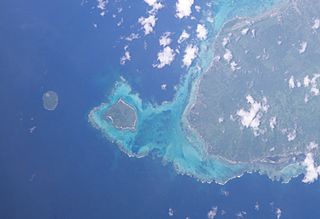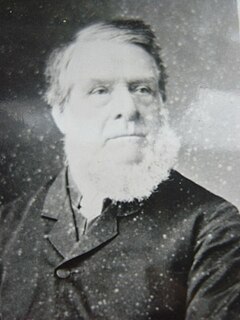
Politics of Samoa takes place in a framework of a parliamentary representative democratic state whereby the Prime Minister of Samoa is the head of government. Existing alongside the country's Western styled political system is the fa'amatai chiefly system of socio-political governance and organisation, central to understanding Samoa's political system.

John Williams was an English missionary, active in the South Pacific. Born at Tottenham, near London, England, he was trained as a foundry worker and mechanic.

Manono is an island of Samoa, situated in the Apolima Strait between the main islands of Savai'i and Upolu, 3.4 km west-northwest off Lefatu Cape, the westernmost point of Upolu.

The London Missionary Society was a predominantly Congregationalist missionary society formed in England in 1795 at the instigation of Welsh Congregationalist minister Dr Edward Williams working with evangelical Anglicans and various nonconformists. It was largely Reformed in outlook, with Congregational missions in Oceania, Africa, and the Americas, although there were also Presbyterians, Methodists, Baptists and various other Protestants involved. It now forms part of the Council for World Mission (CWM).

Gagaʻemauga is a district on the island of Savaiʻi in Samoa. The district is situated on the central north side of Savaiʻi. The name 'Gagaʻemauga' literally means "near side of the mountain", meaning the eastern side of the mountain chain running through the centre of Savaiʻi Island.
Protestants in Tuvalu- Tuvalu is one of the most heavily Protestant nations in the world. The Congregational Christian Church of Tuvalu,, is the de facto state church of Tuvalu, the only established church in the Reformed tradition in the world. Its adherents comprise about 97% of the 12,000 inhabitants of the archipelago, and theologicly it is part of the Reformed tradition.
The Congregational Christian Church of Tuvalu, commonly the Church of Tuvalu, is the state church of Tuvalu, although in practice this merely entitles it to "the privilege of performing special services on major national events". Its adherents comprise about 97% of the ~11,000 inhabitants of the archipelago, and theologically it is part of the Reformed tradition.
Vaiee is a small village on the Samoan island of Upolu. It is located on the central south coast of the island. Notable Faʻamatai titles of Vaiee include the Warrior title of Te'o or sometimes referred to as the 'Anava-o-taua' which literally translates to 'instituter of war', Tuia and Maugatai or also referred to as the 'Matua' which translates to the 'eldest' or the 'first settler'. Other notable matai titles include the orator titles of Lutuimagamau, Lealaimuna, Availepule and Faiavalesua as well as usoalii and other orator titles such as Tula'i, Fuialii, Matauiau, Sagala, Ipiipi etc.

Faleasi'u is one of the largest village settlements on the island of Upolu in Samoa. It is located on the northwestern coast of the island.

Malua is a small village on the Samoan island of Upolu. The name originates from the Samoan word "Maluapapa" which is translated 'shelter under the rock'. It is located on the northwestern coast of the island in the electoral constituency of Sagaga Le Falefa which forms part of the larger political district Tuamasaga. The village is part of the electoral constituency Gaga'emauga III which forms part of the larger political district of Gaga'emauga.

Aaron Buzacott the elder, a Congregationalist colleague of John Williams, author of ethnographic works and co-translator of the Bible into the language of Rarotonga, was a central figure in the South Seas missionary work of the London Missionary Society, living on Rarotonga between 1828 and 1857.

Teo Tuvale was a notable Samoan historian who served terms as Chief Justice and Secretary to Government in Samoa during the era of colonialism.
The Congregational Christian Church of American Samoa (CCCAS) or the "Ekalesia Faapotopotoga Kerisiano i Amerika Samoa" (EFKAS) is a theologically Reformed and congregational denomination in American Samoa.
The Congregational Christian Church in Samoa or Ekalesia Faapotopotoga Kerisiano Samoa is a Reformed and congregational denomination in Samoa.

James Sibree (1836–1929) was an English missionary in Madagascar with an interest in the natural history and cultural history of the island. He was a contemporary of the French naturalist Alfred Grandidier and wrote detailed books about the flora and fauna of Madagascar, the country's general history, and the mission history on the island. He also helped revise the Malagasy Bible and wrote several works in the Malagasy language. He was a vocal advocate of Malagasy independence prior to the French invasion of Madagascar in 1895. Sibree also designed and helped build almost 100 new mission buildings and 50 churches in Madagascar. He was a fellow of the Royal Geographical Society and earned an honorary degree from the University of St Andrews. Swiss zoologist Charles Immanuel Forsyth Major named Sibree's dwarf lemur after him in 1896.
The Reformed Congregational LMS Samoan Church traces its beginnings to the Congregational Christian Church in Samoa (EFKS). Because of minor disagreements with doctrine the church had, this drove the Rev. Tepa Faleto'ese to form a newer and more modern church, The Reformed Congregational LMS Samoan Church. A Malua Theological College graduate and an Elder in the EFKS Church, Rev. Tepa Faleto'ese founded the church in Balmain, Sydney, Australia in 1992, after he retired as church minister for the Congregational Christian Church of Samoa in Aoloau, American Samoa. The Reformed Congregational Church share the same doctrines, rules and rituals as the mother church EFKS, however, do not hold the annual Fa'amati, Faiga Me or any other monetary events aside from the Aso Sa o le Talalelei taulaga. Also, its head office is based in Australia, not in Samoa. The Motto for the Church is "Fa'afaigofie, Fa'ataugofie, Fa'asa'oloto" which translates to "Simple, Humble, Free Worship".

Vailoatai is a village in southwestern Tutuila, the main island of American Samoa. It is located on the eastern end of Leone Bay. The village is known for its beautiful malae located along the island’s rugged southern coast, lined by the fale tali malo of its village chiefs.
Elekana was the first person to introduce Christianity to the Pacific islanders in what is now called Tuvalu. He was born in the Cook Islands in the 19th century, although the dates of his birth and death are unknown.

Fagasā is a village in the Eastern District of Tutuila Island in American Samoa. The village lies by Fagasa Bay, on the north shore of the island. Its name is Samoan and translates to “Forbidden Bay.” The village borders the Tutuila-section of National Park of American Samoa. The trailhead to Mount ‘Alava is located near the village by Fagasa Pass.












